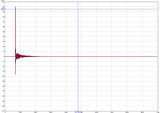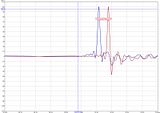well, inspired by the thread (who WAS the Op anyway?? he must be a genius haha), and given that my music chair has been taken back by the manufacturer..to be done properly we hope..I could be a lot more accurate in my physical measuring. With a tape measure. On the floor. Without a chair in the way.
It is almost embarrassing to admit how far out I was...but for the sake of illustration and honesty I'll tell you and just cop the laughs that will follow, and fair enough too. (can I even admit that it never occurred to me to lay the tape on the floor as Don told us he did???)
I thought I was pretty close, but the imaging has been driving me mad! And, to my horror, I found the left and right differed by about three inches. (hangs head in the shame of it all).
So, just to backtrack, I used (audio) measurements to hone in on this. I had
assumed I was close physically.
I used REW to make a sweep of left and right channel, then looked at it in the time domain (most people, and until rather recently myself as well) only ever look at FR.
And only ever 'fix' things with eq. Try telling them that time based problems cannot be cured by eq...........anyway I digress.
The 'normal long range shot' of the impulses
then by changing the graph limits..should be self explanatory..here it is magnified and close up
Hold crtl and shift, then right button on mouse leads to a direct time and distance readout.
Adjust speakers (or chair) accordingly.
Anyway, what prompted me to start the thread (before I found out how wrong I was initially with the physical setup...oh the shame) was how much that timing difference affected things. Sure, it's obvious that it would (and why gary for example stresses in his how to that you need to be down to one mm accuracy) but until you actually experience it you kinda don't know...if you follow.
that was why I was asking 'theoretically' whether it's a case of 'close enough is good enough' etc etc.
I have the advantage of being able to 'cure' that time delay by setting a delay on the appropriate speaker in the deqx, and time align them that way.
It also meant I could leave that delay in another profile, and switch between the two with a push of a button on the remote.
I gotta tell you, the difference is quite amazing (hence the thread, I was so 'stunned' by it). As an example, the time difference between the two channels was 200/1 000 000 of a second. Spose I should reduce that, but hey I'm not in school now!! Ok, 2/10 000 of a second difference.
The shift in the image was easily eight inches or so, and to bring it back to centre using vol offset required around
2 db! That seemed staggering to me....until I read gary's how to which goes into it.
And of course the difference did not stop there, the centre image felt far more natural (done time wise-ie properly-than with blunt vol balance adjustment), the ambience was far better and less forced.
So, if anyone is 9ineterested, here is an alternative way to do a final check on the distance between left and right channels, throw a mic at the lp (as long as it is on the centre line and facing forward), do a sweep left and right and compare.
Old hat to a lot I guess, maybe a way to confirm you have it to whatever arbitrary degree of accuracy you think you have.
I'm on a new crusade, 'give me time response over frequency response' haha. Well, I'll take both if I can get it, but time is far more important I think.

















